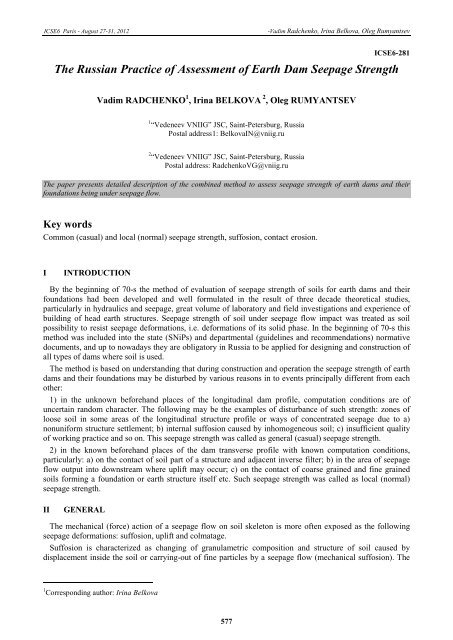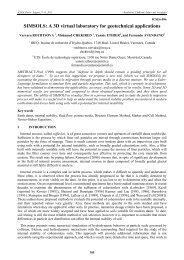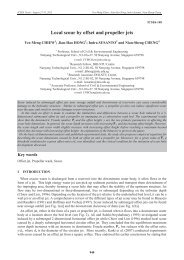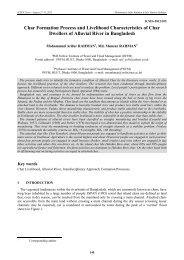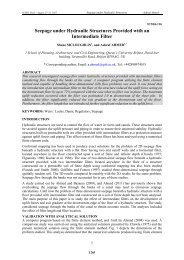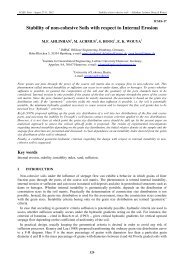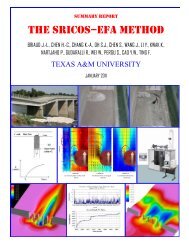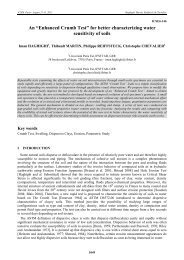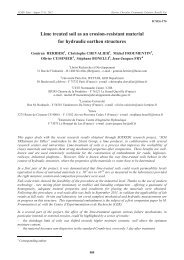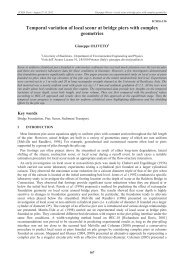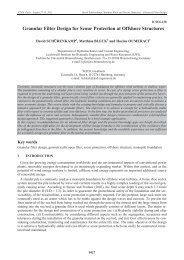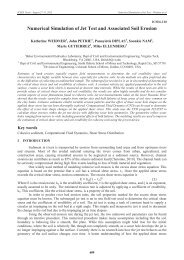The Russian Practice of Assessment of Earth Dam Seepage Strength
The Russian Practice of Assessment of Earth Dam Seepage Strength
The Russian Practice of Assessment of Earth Dam Seepage Strength
You also want an ePaper? Increase the reach of your titles
YUMPU automatically turns print PDFs into web optimized ePapers that Google loves.
ICSE6 Paris - August 27-31, 2012-Vadim Radchenko, Irina Belkova, Oleg RumyantsevFigure 2: Contact erosion <strong>of</strong> soila –coarse-grained soil – fine-grained soil; b - coarse-grained soil – clay (cohesive) soil; c –cracked rock – clay or finegrainedsoil; ϑ - angle between directions <strong>of</strong> seepage velocity and gravity force; D o –average size <strong>of</strong> coarse-grained soilseepage pores; d sp –dimension <strong>of</strong> (suffosion) fine-grained soil particles which may be carried out by seepage flow;k r – permeability factor <strong>of</strong> rock; k s – permeability factor <strong>of</strong> soil; b c – crack width.For this we, at first, determine the critical gradient <strong>of</strong> contact erosionI ,<strong>of</strong> fine-grained (or cohesive)soil. Its value depends on size <strong>of</strong> grain composition fractions <strong>of</strong> contacting soils. <strong>The</strong>n the obtained meaning(value) I ,is compared with concrete hydrodynamic conditions <strong>of</strong> the seepage flow in the structure or itscr celement. Experimental methods to define values <strong>of</strong>non-cohesive and cohesive (clay) soils were developed.VI.4.1cr cDetermination <strong>of</strong> critical gradients <strong>of</strong> contact erosion for non-cohesive soils.cr cI ,depending on sizes <strong>of</strong> their grain compositions forIf two nonuniform non-cohesive soils (or soil with cracked rock) contact between each other, the criticalgradient <strong>of</strong> fine-grained soil erosion and dimensions <strong>of</strong> carrying-out particles with the diameter d ≥ 3% isdetermined by the experimental equation [Pravedny, 1976 – 1991]:Icr , c=1 ⎛ dsp⎞ dsp⎛ ϑ ⎞⎜2, 3 + 15⎟ sin ⎜30+ ⎟ , (12)ϕ ⎝ D0⎠ D0⎝ 81⎠where: ϕ1–the coefficient accounting for the shape and roughness <strong>of</strong> soil fractions.At that the relation isdsp < 0.7. With the relationdsp ≥ 0.7 there is no erosion and carrying-out <strong>of</strong> fine-D0D0grained soil fractions. <strong>The</strong> average diameter <strong>of</strong> fine-grained soil seepage pores is determined by the equation(9).<strong>The</strong> equation (11) may be used to determine the critical gradient <strong>of</strong> fine-grained soil erosion on the contactwith cracked rock (Figure 2c), but the value bс, crack expansion in rock, should be substituted into theequation (11) instead <strong>of</strong> D0.VI.4.2Determination <strong>of</strong> critical gradients <strong>of</strong> contact erosion for cohesive (clay) soils.In case there are contacts between cohesive (clay) soil and coarse-grained material or with cracked rock(Figure 2b, c), the cohesive soil may be eroded.<strong>The</strong> value <strong>of</strong> the critical erosion gradient Icr , cat contact seepage: cohesive (clay) soil with plasticity indexIP- coarse-grained soil (or cracked rock), may be determined by the experimental equation [Pravedny]:Icr , c= 1− 0.75 , (13)maxDwhere:maxD – is determined by the equation (4) for coarse-grained soil, at that00spmaxD ≤ 0.018 m (with0maxD > 0.018 m the cohesive soil will be separated in pores <strong>of</strong> coarse-grained material, the contact erosion).0583
ICSE6 Paris - August 27-31, 2012-Vadim Radchenko, Irina Belkova, Oleg Rumyantsev<strong>The</strong> equation (12) may serve to determineI ,at the contact: cohesive soil – cracked rock (Figure 2c). Incr cthis case the maximum value <strong>of</strong> crack expansion should be substituted into the equation (12) instead <strong>of</strong>maxD .0VI.4.3 Determination <strong>of</strong> critical gradients <strong>of</strong> contact erosion for cohesive soils with plasticity index I P < 5.Many researchers observed that cohesive soils with plasticity index I P < 5 (2-4) – loamy sand, poor loamysand differ from more plastic soils by seepage-strength properties.On the base <strong>of</strong> experimental studies <strong>of</strong> clay soil with plasticity index I P ≤ 6 for contact erosion with gravelfilter, graphical equation <strong>of</strong> admissible contact erosion gradient was obtained:I cont sc adm = f (D о 60c, d ag ), where D о 60c – calculated diameter on the contact with loamy sand, d ag – calculateddiameter <strong>of</strong> soil aggregate forming at erosion. Numerical values <strong>of</strong> f can be found from diagrams in[Mishurova 1970, 1975].<strong>The</strong> admissible gradient shall be equal to:I cont.scadmcont.scInorm= , (14)1.5 ⋅ kwhere k –the coefficient depending on the slope <strong>of</strong> eroded surface, its values are determined by standrads.VII CONCLUSIONSPractically fail safe operation <strong>of</strong> earth and rock-fill dams, constructed in the USSR, Russia and othercountries for more than seventy-year period, demonstrates that the described method <strong>of</strong> local and generalseepage strength, used for dam designing, is justified and provides operational reliability <strong>of</strong> structures.VIII ACKNOWLEGMENTS AND THANKSWe are grateful to Dr. Valentina Burenkova for encouraging us and helping to write this paper.IXREFERENCES AND CITATIONSChugaev R.R. (1962). – Underground outline <strong>of</strong> hydroengineering structures. Publishing House“Gosenergoizdat”. Moscow-Leningrad.Chugaev R.R. (1965). – On calculations <strong>of</strong> seepage strength <strong>of</strong> dam foundations. “Hydrotekhnicheskoestroitelstvo” (Hydrotechnical Construction) Issue 2. Moscow.Chugaev R.R. (1968). – <strong>Earth</strong> hydroengineering structures (theoretical calculation basis). Energoizdat.Leningrad.Patrashev A.N. (1935). – Pressure flow <strong>of</strong> ground water carrying fine sandy and clayey particles. Isvestiya.B.E. Vedeneev VNIIG. Vol. 15, 16. Leningrad.Patrashev A.N., Pravedny G. Kh. (1965). – Manual on designing <strong>of</strong> reverse filters for hydroengineeringstructures. VSN-02-65/GPKE and E USSR.Pavchich M. (1961). – Method <strong>of</strong> determination <strong>of</strong> nonsuffusion soils grain size distributions. Isvestiya.B.E. Vedeneev VNIIG. Vol. 68. Leningrad.Pavchich M., Balikov B.I. (1976). – Methods to determine soil permeability factors. Publishing House“Energiya”. Leningrad.Pavchich M. (2006). Transition filters XIII Danube-European Conference on Geotechnical Engineering.Active geotechnical design in infrastructure development. Proceedings. Vol. 2 Ljubljana. SloveniaBurenkova V.V., Mokran B. (1983). – On substantiation <strong>of</strong> reliability <strong>of</strong> suffusion soil strength inhydroengineering structures. “Hydroengineering construction .Burenkova V.V. (1992). – <strong>Assessment</strong> <strong>of</strong> suffusion processes in loose inequigranulas soils. Int. Congress<strong>of</strong> filters and filtration phenomena in geotechnical engineering. Karlsruhe. Germany.Pravedny G.K. (1976). – Guideline on calculation <strong>of</strong> seepage strength <strong>of</strong> dams made <strong>of</strong> soil materials.Leningrad. Publishing House “Energiya”. 55-76 pPravedny G.Kh. (1991). – Recommendations on designing <strong>of</strong> reverse filters for hydroengineeringstructures.VNIIG. St.-Petersburg. 56-90 p584


